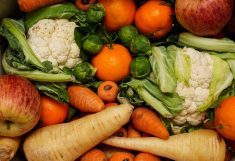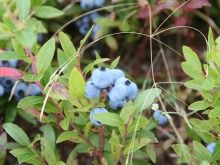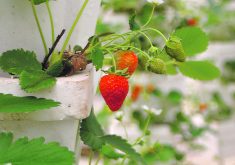Incorporating weeping properties would be an additional economical and labour-saving advantage for apple growers
The practice of tying down apple tree branches to improve productivity has been done for more than a century.
How the practice works has not been fully understood, however studies have shown that bending the branches helps the trees provide more nutrients and carbon toward flowering and fruiting rather than toward leaf and branch growth.
In rare cases, trees will naturally grow downward, in a phenomenon known as weeping.
Now, scientists at Cornell University in New York have identified a variation (L195P) of a gene known as MdLAZY1A that controls this weeping growth characteristic in apple.
Read Also

Saskatchewan throne speech promises strong economy
Saskatchewan’s legislative agenda for the coming year will focus on meeting the challenges of new world trading relationships, said the speech from the throne.
Kenong Xu, associate professor in the School of Integrative Plant Science Horticulture Section at Cornell, said to encourage early fruiting in young orchards and continuously maintain productivity, growers regularly trained apple trees with several methods, including bending branches.
He said researchers are particularly interested in improving branch growth direction in widely grown apple cultivars such as Gala, Fuji, and Honeycrisp.
According to Statistics Canada, in 2022, Canada’s apple production volume was 380,571 tonnes, which accounted for 39.8 percent of total production of Canadian fruit that year.
Being able to take advantage of genetic improvements by incorporating weeping properties would be an additional economical and labour-saving advantage for apple growers.
Plant architecture, or the natural development of a tree from seeding and sprouting to senescence, is among the most important factors that determine yield and production.
The research team used a process called forward genetics, where they looked at the traits in more than 1,000 offspring of weeping cultivars, separating those with weeping characteristics compared to those of normal growth.
“Forward genetics refers to a genetic approach that is used to identify specific genes or genes relating to a phenotype of interest, such as the weeping growth habit in apple,” said Xu.
With the selected cultivar samples, they used genetic sequencing techniques to compare two populations to locate the genetic characteristic. They identified a mutation, a single nucleotide substitution to the MdLAZY1A gene controlling weeping. This confirmed that the downward growth is caused by the mutation of genes involved in directional growth.
With that knowledge, future apple breeders may take advantage of CRISPR/Cas-9 gene-editing technology to develop cultivars with weeping characteristics.
“We confirmed (the mutation) through multiple transgenic studies,” said Xu. “We put that allele in a standard Royal Gala apple cultivar and the tree grew downward. The greatest potential that the research findings offer for apple growers is to reduce or eliminate the need for (manually) bending branches in the orchard.”
The mutation discovered by the scientists occurs in less than one percent of trees.
“In natural settings, the mutation rate for a visible phenotype is estimated lower than 0.01 percent in plants although the rate can vary greatly among different species,” said Xu. “Trees with the weeping growth habit have been reported in at least peach, orange, and chestnut, in addition to apple.”
He said LAZY1-like genes are found in most plant species, if not all, but the mutation in the apple LAZY1 gene is specific to apple.
Xu referred to two weeping apple garden varieties, one being the Red Cascade originally from Siberia. It is a semi-dwarf rootstock, survives well in cold winters under snow and grows to about three metres at maturity. As a garden variety, it will grow as a weeping and fruiting apple tree.
Another garden variety he referenced is the Malus Wandin Pride weeping apple that also reaches a height of three metres at maturity.
While Xu has not received feedback from apple breeders on the findings, he is encouraged with the potential opportunities the research offers.
“It is genetically plausible to state that the mutation is an effective target for CRISPR-based gene editing to change the branch growth directions in apple.”
Research on the weeping phenomenon and branch directional growth continues.
“Although studies in plant physiology have demonstrated that branch bending encourages flowering and fruiting, the exact mechanisms explaining the beneficial effects remain to be unravelled,” he said.
The research was recently published in the journal Plant Physiology.















